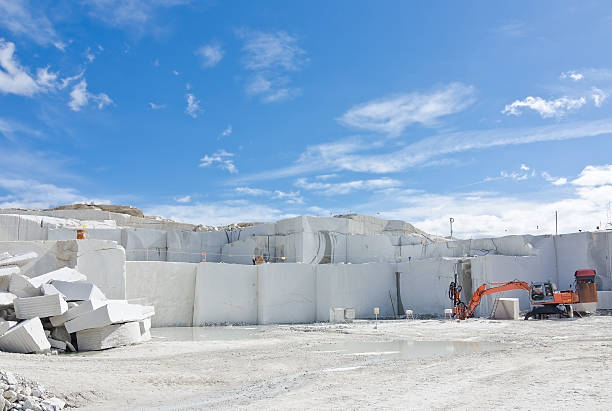Granite Quarries in South Africa Marvels: Discovering the Quarry Landscape
Granite Quarries in South Africa Marvels: Discovering the Quarry Landscape
Blog Article
Discovering the Rich Background and Sustainable Practices of Granite Quarrying
As we stand on the precipice of discovering the elaborate tapestry of granite quarrying, a journey via time discloses not simply the physical act of removing stone but likewise the social and historical significance woven right into the really material of this method. From the ancient origins that laid the foundation for contemporary quarrying techniques to the lasting practices that are shaping the future of this industry, each sculpt mark on granite surfaces narrates waiting to be unearthed (granite quarries in south africa). The legacy of granite quarrying extends far beyond mere extraction; it is a testimony to human resourcefulness, resilience, and the long-lasting allure of this majestic rock
Ancient Beginnings of Granite Quarrying
Dating back to ancient worlds, the method of quarrying granite has been an essential component of human history and architectural development. The earliest evidence of granite quarrying days back to ancient Egypt, where enormous pyramids and detailed sculptures were crafted from this durable stone. The Egyptians made use of primitive devices to extract granite blocks from quarries, showcasing the value of this product in their huge buildings.
Moving onward in background, the Greeks likewise made substantial contributions to the quarrying of granite. The Greeks utilized granite in different building wonders, such as holy places and statues, demonstrating their skill in shaping and carving this sturdy rock. The Romans better improved the techniques of quarrying granite, employing sophisticated tools like blades and hammers to essence and form granite for their legendary frameworks.
Via the centuries, the practice of quarrying granite has evolved, with modern technologies improving effectiveness while preserving the ageless charm of this natural stone - granite quarries in south africa. From ancient worlds to modern building contractors, the tradition of granite quarrying proceeds to shape our world
Evolution of Quarrying Techniques
The evolution of quarrying strategies has actually been noted by a constant progression towards greater efficiency and accuracy in removing granite. From the primary approaches utilized by our ancestors to the sophisticated technologies made use of in modern-day quarrying operations, the industry has actually undertaken considerable developments. Early quarrying techniques involved manual work with standard tools such as chisels, hammers, and wedges to remove granite blocks from the planet. As people advanced, methods like fire-setting and primitive nitroglycerins were presented to facilitate the extraction procedure.
Innovations in computer-controlled tools and 3D modeling have optimized quarrying operations, leading to very little ecological influence and improved sustainability practices. As the demand for granite continues to increase, the evolution of quarrying techniques remains essential to meeting sector requires effectively and sustainably.
Social Value of Granite
Granite holds a profound social value throughout different civilizations due to its long-lasting visibility in building masterpieces and revered monuments. The social value of granite prolongs beyond its physical attributes; it personifies strength, stability, and timelessness, making it an icon of sustaining legacies and customs.

Sustainable Practices in Quarrying
Amidst the abundant background of granite quarrying and its social importance lies an expanding focus on sustainable practices within the industry. As ecological recognition and worries regarding resource depletion have actually increased internationally, the quarrying market has actually progressively accepted lasting approaches to decrease its influence on the setting and surrounding areas.

Furthermore, reclamation and rehab of quarry sites post-extraction are important to lasting techniques. By recovering quarried locations to a natural or advantageous state, such as developing wildlife habitats or recreational spaces, quarriers can balance out the environmental footprint of their operations and contribute positively to the regional community.
Legacy of Granite Quarrying
With a historical backdrop steeped in craftsmanship and industrial progress, what enduring influence has granite quarrying left on the landscape of modern-day culture? The heritage of granite quarrying goes beyond simple extraction methods; it has shaped building wonders, urban landscapes, and social heritage worldwide. The sturdy nature of granite has actually made it a recommended option for monoliths, buildings, and infrastructure, standing as browse this site a testament to the ability and virtuosity of quarry employees across generations.
Additionally, the economic footprint of granite quarrying can not be forgotten. The sector remains to supply employment possibility and drive local economic situations in areas where granite extraction is widespread. It has actually also spurred technological advancements in quarrying techniques and devices, leading to more reliable and sustainable methods.
In regards to sustainability, the legacy of granite quarrying includes initiatives to alleviate environmental influences through recovery projects and accountable source administration. By stabilizing economic rate of interests with ecological stewardship, the market makes every effort to guarantee that future generations can proceed to gain from this enduring natural deposit.
Conclusion

Report this page